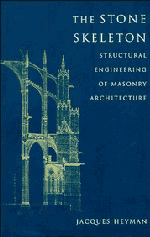3 - Domes
Published online by Cambridge University Press: 05 August 2014
Summary
A dome is a rounded vault forming a roof over a large interior space (e.g. Hagia Sofia, c. AD 532 with a span of about 31 m; St Peter's Rome, c.1560—90, 42.5 m). The word in Italy (duomo) and Germany (Dom) has come to stand for the whole cathedral, and indeed the etymology is from the Latin domus, house (of God). The French use both dôme and coupole (cf. Italian cupola) for the vault; the English cupola is sometimes reserved for a very small domed roof, as for example on the lantern mounted on the eye of a dome proper, cf. the cross-section of St Paul's Cathedral shown in fig. 8.9.
The ‘rounded vault’ of the dome can take many forms. Perhaps the simplest of these is a shell of revolution, in which every horizontal section is circular; an egg in an egg-cup is a shell of this kind. The inner dome of St Paul's is roughly spherical, and has an open eye, while the main dome carrying the lantern is conical, but both are shells of revolution, as is the surface of the third lead-covered timber outer dome; all have circular horizontal sections.
- Type
- Chapter
- Information
- The Stone SkeletonStructural Engineering of Masonry Architecture, pp. 27 - 47Publisher: Cambridge University PressPrint publication year: 1995



